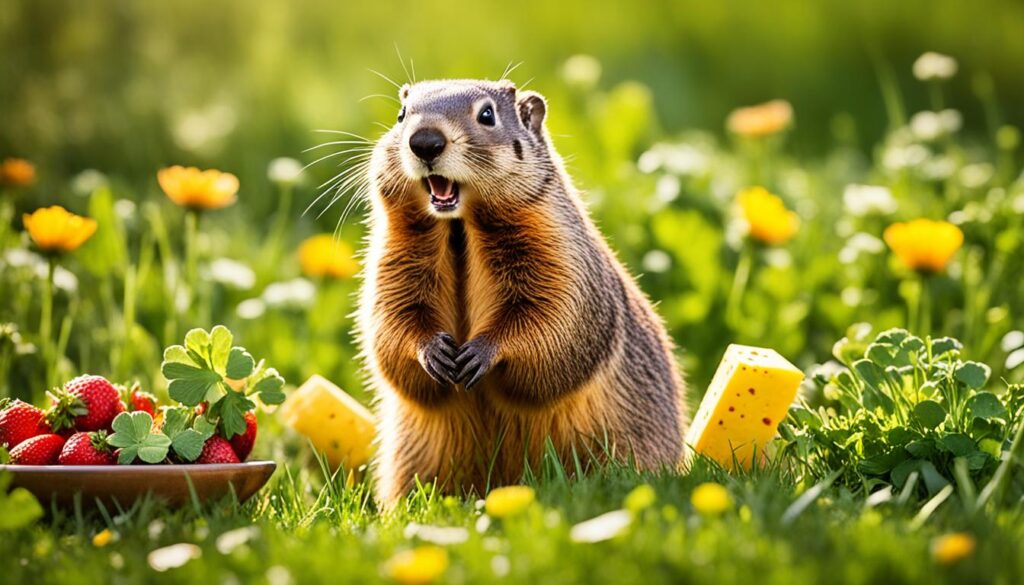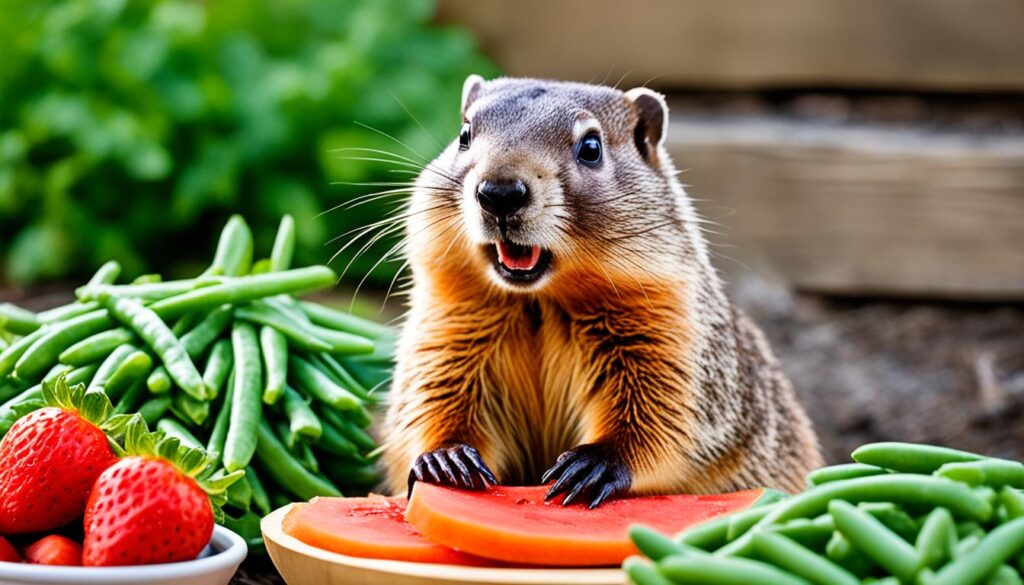Did you know groundhogs eat up to one-third of their body weight daily? This fact makes knowing what they like to eat crucial for their health and our gardens. We’ll explore their favorite foods, showing how they affect their health and the environment.
Learning about groundhog diets is key for those interested in their behavior and how they affect the environment. Groundhogs, also known as woodchucks, are mainly plant-eaters. They like a wide variety of plants.
Overview of Groundhog Feeding Habits
Groundhogs eat a mix of grasses, plants, fruits, and veggies. They usually eat during the day, especially in the morning and late afternoon. Their eating habits change with the seasons, based on what’s around them. Knowing about their eating habits helps protect gardens and crops.
Why Knowing What Groundhogs Eat is Important
Knowing what groundhogs like to eat can benefit gardeners and homeowners. This knowledge allows them to protect their gardens and helps keep the ecosystem balanced so groundhogs and plants can live together well.
What Do Groundhogs Like to Eat
Groundhogs have interesting eating habits. They prefer certain plants and forage in unique ways, changing with the seasons.
Common Plants in a Groundhog’s Diet
Groundhogs eat a variety of foods, but they like some plants more than others. They often eat:
- Grasses and clover
- Alfalfa
- Dandelions
- Garden vegetables like lettuce, carrots, and beans
These plants are a big part of their diet. They love fresh, green foods.
Groundhog Foraging Patterns
Groundhogs forage in a specific way. They dig burrows near food sources to save time. In the early morning and late afternoon, they’re out eating their favorite plants.

Seasonal Changes in Groundhog Food Preferences
Groundhogs change what they eat with the seasons. In spring and summer, they eat lots of fresh greens and veggies. But as fall comes, they start eating more fruits, grains, and nuts. This helps them get ready for hibernation.
This change in diet makes sure they have enough fat for winter.
Groundhog Food Preferences
Groundhogs love to eat a variety of foods. Knowing what they like helps you manage their impact on your garden.
Preferred Vegetables and Greens
Groundhog meal choices often include vegetables and greens. They especially like tender, leafy greens. Your garden might become a favorite spot with foods like:
- Lettuces
- Kale
- Spinach
- Beans
- Peas
- Broccoli
Adding these preferred foods for groundhogs can attract these furry visitors to your garden.

Fruits That Groundhogs Enjoy
Groundhogs also enjoy sweet fruits. Some top choices include:
- Apples
- Pears
- Plums
- Peaches
- Berries
If you have fruit plants or trees, groundhogs might come to your yard for these treats.
Grains and Seeds in a Groundhog’s Diet
Grains and seeds are also part of their diet. They provide important nutrients. Groundhogs often eat:
- Oats
- Wheat
- Sunflower seeds
These foods help ensure they have a balanced diet in their natural habitats.
Understanding groundhog meal choices helps you manage their impact on your garden.
Groundhogs and Human Gardens
Groundhogs, also known as woodchucks, can be both a delight and a problem in gardens. They love to eat a variety of plants found in gardens. This includes everything from vegetables to leafy greens.
Knowing how groundhogs behave can help you deal with them. They mainly eat plants and love tender veggies and greens. Favorites include lettuce, beans, peas, and broccoli.
Feeding groundhogs in the wild might seem like a good idea, but it could lead to more problems. It might make them visit your garden more often. This could harm your plants and crops. To reduce their impact, you can try these steps:
- Fencing: A tall, strong fence can keep groundhogs out.
- Repellents: Use natural or store-bought repellents to make your garden less inviting.
- Plant Selection: Choose plants that groundhogs don’t like, like flowers or tough greens.
Using these methods can help you and groundhogs live in harmony. It protects your garden and respects the animals’ natural ways. So, while you might want to feed them, managing their garden visits is key to avoiding damage.
Groundhog Nutritional Needs
It’s important to know what groundhogs need to eat to stay healthy. They need a mix of nutrients to stay active and support their daily life. We’ll look at the key nutrients and how to balance their diet.
Essential Nutrients for a Healthy Groundhog
Groundhogs need vitamins, minerals, and other nutrients to be healthy. These come from fruits, veggies, and greens they find in the wild. Vitamins A, C, and B-complex are important for their health.
Calcium, phosphorus, and magnesium help with strong bones and muscles. Fiber is key for their digestion, and water keeps them hydrated and supports their metabolism.
Balancing Groundhog Meals
Feeding groundhogs right is more than just offering many foods. It’s about making sure they get all the nutrients they need. They naturally eat a variety of foods to get what they need.
They eat leafy greens, berries, nuts, and grains. Changing what they eat throughout the year helps prevent nutrient shortages. Watching wild groundhogs can teach us how they balance their diets.
Groundhog Foraging Patterns and Their Impact
Groundhogs play a big role in their ecosystems through their foraging habits. By studying how they interact with their surroundings, we can see the delicate balance they keep in their habitats.
Impact on Local Ecosystems
Groundhogs have both good and bad effects on ecosystems. They improve soil health by digging burrows. But, they also eat plants, which can lead to deforestation and less plant variety. This shows how complex their role is in nature.
Groundhog Interaction with Other Wildlife
Groundhogs are key to the ecosystem because of their relationships with other animals. They are food for foxes and hawks, helping the food chain. Their burrows are homes for rabbits and snakes, showing how important they are for other species.
These interactions affect many species and behaviors in the ecosystem. It shows how groundhogs play a big part in nature.
Groundhogs play a big role in their ecosystems with their eating habits. They love to eat vegetables, fruits, grains, and greens. These foods change with the seasons, showing how adaptable their diet is.
Groundhogs affect the environment and farms a lot. They help other animals and plants grow. But, they can sometimes eat too much in gardens. With the right knowledge, we can live with them peacefully.
Understanding what groundhogs eat is key for everyone. This guide has shown us what they like to eat. It helps us appreciate these animals more and respect their place in nature. With this knowledge, we can live better with groundhogs.
FAQs
What are the favorite foods of groundhogs?
Groundhogs love to eat clover, dandelions, and alfalfa. They also enjoy vegetables and fruits from gardens.
Why is it important to understand groundhog feeding habits?
Knowing what groundhogs eat helps us manage their impact on our gardens. It also helps us understand their role in nature and their nutritional needs.
What types of food do groundhogs typically eat?
Groundhogs eat grasses, leaves, flowers, and bark. They also eat crops and garden plants like lettuce, beans, and carrots.
How do groundhog foraging patterns change with the seasons?
In spring and summer, groundhogs eat a lot of fresh greens and veggies. In fall, they eat more fruits and grains to get ready for hibernation.
What vegetables and greens do groundhogs prefer?
Groundhogs like vegetables and greens like lettuce, spinach, peas, and beans. They look for these in gardens.
What fruits are commonly found in a groundhog’s diet?
Groundhogs eat fruits like berries, apples, and pears. These fruits are important for their diet.
Do groundhogs eat grains and seeds?
Yes, groundhogs eat grains and seeds. They find grains in farmlands and seeds in various plants.
How do groundhogs affect human gardens?
Groundhogs can damage gardens by eating vegetables and plants. Their digging can also harm the soil and roots, affecting crops.
What are the essential nutrients for a healthy groundhog?
Groundhogs need a diet full of proteins, vitamins, and minerals to stay healthy. They get these from plants, vegetables, fruits, and seeds.
How do groundhogs naturally balance their meals?
Groundhogs find a variety of foods to eat, making sure they get all the nutrients they need. They eat based on what’s available seasonally.
What is the impact of groundhog foraging on local ecosystems?
Groundhog foraging affects plants and soil. Their eating habits help spread seeds and shape plant patterns, keeping the ecosystem balanced.
How do groundhogs interact with other wildlife?
Groundhogs compete with other animals for food and create homes through their burrows. They are important in their ecosystems and affect other animals’ presence.
